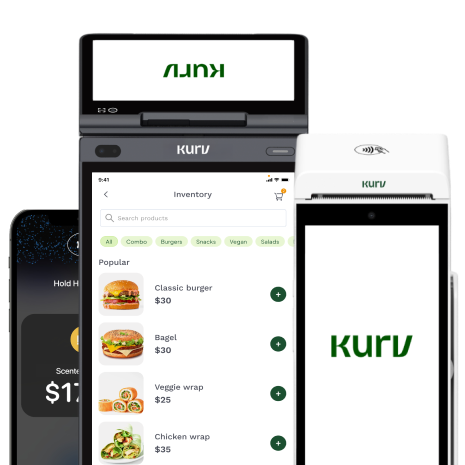Whether you’re selling handmade scarves, 3D-printed toothbrushes, or custom artwork, you need an eCommerce site with the power to process customer payments.
So, how do you add payment processing to a website? While the general process is pretty simple, the nitty-gritty work takes some in-depth technical expertise—and if you’re not a cybersecurity expert, an accountant, or a master web developer, the idea can seem daunting.
Kurv has over 3 decades of payment processing experience under our belts. So, we’re here to teach you how to add payment processing to a website by defining some key terms, breaking down the entire process into six steps, and answering a few FAQs.
Key Takeaways:
- From handmade crafts to high-tech products, the right payment processing setup turns browsers into paying customers.
- Be wary of companies that advertise on social media and through search engines but do not have an established reputation.
- Professional integration protects against fraud, boosts customer confidence, and keeps payments lightning-fast.
- Equip your eCommerce site with the right payment processing tools to convert every visitor into a paying customer.
What Should You Know Before You Start the Payment Processing Procedure?
Before we get started, let’s define some key terms:




Incorporate Payment Processing Into Your Brand website in 6 Steps
With definitions out of the way, let’s break down how to add payment processing to your eCommerce site.
#1 Ask Your Website Host About Payment Gateway Compatibility
Your website host may:
- Only allow you to use certain payment gateway brands (for cybersecurity or compatibility reasons)
- Offer in-house gateway services to cut out the middleman
- Recommend one or multiple brands, but may not require you to choose one of their partners
It’s crucial that you ask the host about any of the above before signing on the dotted line—ideally before you even choose your web host.
#2 Choose a Payment Gateway
Once you know what your web host will allow, it’s time to choose a payment gateway for your eCommerce site. But, while you’re browsing, there’s another player to keep in mind—your website’s shopping cart software.
While they’re building your site, your web developer will likely use third-party software to build a shopping cart system that:
- Keeps track of what your customer wants to buy
- Applies discounts
- Displays the visuals of the checkout process to your client
Keep in mind that your gateway of choice will also have to play nice with your shopping cart software—your web developer can help you choose a compatible gateway.
#3 Sign Up for Merchant Services (AKA a Merchant Account) and Link Them to the Gateway
If you plan to accept credit and debit cards for purchases, you simply can’t do business without a merchant services provider. While shopping for a provider, ask them about:
- Their fee structure – Merchant services providers typically charge three kinds of fees: [2] Forbes. “Credit Card Processing Fees: The Ultimate Guide” Accessed August 15th, 2024.
- Interchange fees (which go to the credit card company)
- Payment processor fees (which go to the merchant services provider)
- Assessment fees (which also go to the credit card company, but they’re based on monthly sales instead of per-transaction percentages)
- Their additional services – Ask about loyalty program administration, point of sale (POS) system rentals, and statement services.
- How to save on merchant services – A good provider will offer free rate reviews to their members, negotiate their rates with credit card companies, and help businesses build processing fees into the prices of items.
Once you choose a provider, send them the information they’ll need to connect to your payment gateway.
#4 Build Your eCommerce Store
Building an eCommerce store is the subject of many (much longer) articles, and it isn’t always a simple process. We recommend hiring a web developer for this process because:
- It can be cheaper than doing it yourself (if you’re not a tech whiz or master coder).
- A professional can help you build a secure site that your clients can trust.
- They understand how all the moving parts fit together—web hosting, shopping cart software, payment gateways, and website functionality.
#5 Add Your Accepted Payment Methods to the Store
Like the step above, we recommend entrusting your web developer with the task of adding payment methods to your site for a few reasons:
- Typically, a single payment gateway will handle all card types you desire to accept, which means one gateway will work for Visa, Mastercard, Discover and American Express.
- A coding expert can help your website look and play nice with your chosen gateway.
- You want your site and your payment infrastructure to be airtight from a cybersecurity standpoint.
#6 “Testing, 1, 2… Is This Thing On?”
Your payment gateway should offer a method for testing the entire process top-to-bottom to make sure it works. During the testing process, make sure that all of the following work as expected:
- All of the payment methods you accept (e.g., Visa, MasterCard, and American Express)
- Discount codes or sales (make sure the price changes to reflect the “deal”)
- Communication between the gateway and your merchant services provider
- Acceptable page load times between your site and the external gateway, if you’re using one
And going forward, you should test the process if you make any changes to your gateway, web host, shopping cart software, or merchant services provider.
What’s Next?
Generally speaking, adding payment processing to your website is simple—but each phase in the process requires in-depth expertise, which is why we recommend consulting with experts as often as possible.
When it comes to expertise and experience in the merchant services sphere, no one bests Kurv. We’re far from newcomers to eCommerce and credit card processing—we’ve been working with brands just like yours for over three decades.
We offer traditional merchant services but can also provide POS equipment, help you build loyalty programs, consult on surcharges and cash discounts, and so much more.
Our solutions are developed with your business—and your bottom line—in mind. Contact us to learn more about how we can help your business grow.
Frequently Asked Questions
Do I Have to Hire a Web Developer, eCommerce Site Builder, Payment Gateway Provider, and Merchant Services Provider?
For the same reason that each of the above steps is described in limited detail, you probably want to hire experts for anything you don’t know how to do yourself when it comes to eCommerce—when you zoom in, it’s a complicated procedure.
Even if you think you can handle it after a few YouTube tutorials, you should probably still consider hiring these tasks out because:
Both learning and building take time—as a business owner, you have enough on your plate.
Cybersecurity is critical to eCommerce—secure sites protect both you and your clients from fraud.
How Much Is All of This Going to Cost?
The cost of your eCommerce site-building will depend on:
The cost of your web hosting services
The size and complexity of your site and inventory
Your merchant services provider’s fees
The amount of time and expertise your web developer will need
But remember that this will mostly constitute a one-time cost. Once your site is done, you’ll only need to perform software updates and regular maintenance.
Where Can I Find More Expert Help?
Luckily, everyone you hire to help you build an eCommerce site can offer:
Their industry-specific expertise
Recommendations for other experts
Software and web hosting preferences
The top qualification you should look for in an expert is their experience—how many sites have they




























